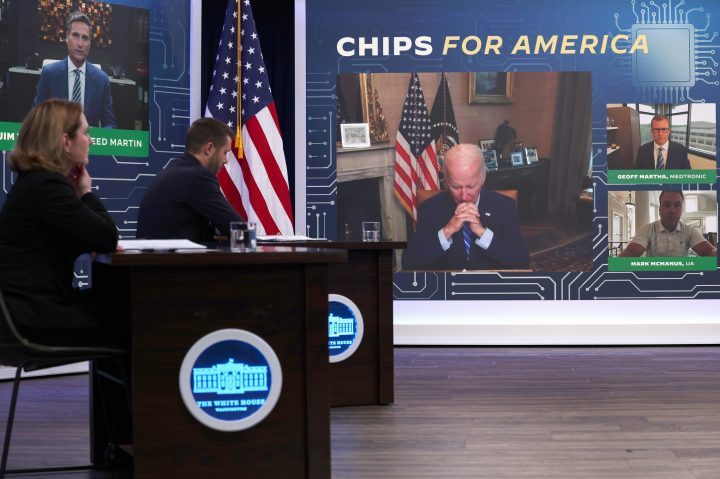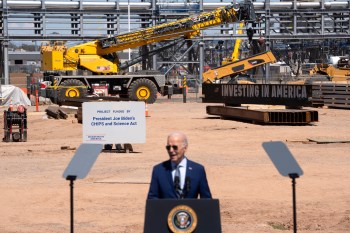
The science part of the CHIPS and Science Act

The $280 billion CHIPS and Science Act sets aside a lot of money for, you guessed it, those high-demand semiconductor chips. But a good chunk of that fund is earmarked to advance scientific research across several areas.
That could mean big things for the National Science Foundation. Over the course of five years, $81 billion could be directed to the organization, the largest funding increase the NSF has seen since it was created back in 1950.
“This would essentially unleash a new era of [science, technology, engineering and mathematics] in America through research and technology, with STEM education and training, by creating jobs and expanding the geography of innovation to accelerate scientific discovery for tremendous impacts,” said the foundation’s director, Sethuraman Panchanathan.
Marketplace’s Sabri Ben-Achour spoke with Panchanathan about what this significant boost in funding could mean for the future of scientific research and innovation at the NSF. The following is an edited transcript of their conversation.
Sabri Ben-Achour: So, $81 billion over five years. What will this translate to at the National Science Foundation?
Sethuraman Panchanathan: First of all, the CHIPS and Science Act 2022 is a historic bipartisan legislation. I just want to emphasize it is not just about chips, it’s about unlocking investments in American science and technology that will drive our economy and national security for decades to come. So when we talk about the $81 billion in that over five years, this would essentially unleash a new era of STEM in America through research and technology, with STEM education and training, by creating jobs and expanding the geography of innovation to accelerate scientific discovery for tremendous impacts.
The NSF’s DNA
Ben-Achour: There was some disagreement when this money was being negotiated over what kind of science it should fund. You know, there’s like the the general basic stuff, the science for science’s sake, which NSF is known for, versus focusing on science used in industry, used in tech, with like a clear economic application. In the end, what kind of science will this money be used for?
Panchanathan: You know, it’s a very good question. When I talk about NSF, if you look at the last seven decades of NSF’s journey and what it has made possible for our nation, I describe it often as the DNA of NSF. Like a DNA which has two strands which are intertwined and highly synergistic. One of those trends that you talked about that NSF makes possible and known for is curiosity-driven, discovery-based explorations. At the same time, NSF has also made possible through the other strand use-inspired, solutions-focused translations or innovations. These, as I said earlier, are highly synergistic and symbiotic. In other words, explorations make possible fantastic innovations. But innovations, in turn, also make possible more explorations. There are many, many examples in this regard, when you look at the journey of science and technology. And so with this investment, NSF is going to unleash both curiosity-driven research as well as use-inspired, solutions-focused research. But most importantly, it is going to make possible unbelievable talent across the broad geography of our nation, the broad socioeconomic demographic of our nation, the rich diversity of our nation. Because we know that talent and ideas are democratized and are everywhere. And we want to make sure that talent everywhere is energized, inspired, motivated and brought to life.
Ben-Achour: There’s $20 billion set aside for something that was recently created at NSF called the directorate for technology, innovation and partnerships. What is that? What’s that going to do?
Panchanathan: The technology, innovation partnerships is going to rapidly translate the fantastic curiosity-driven research ideas and innovations that NSF is making possible all across our nation through our investments. And working in partnership with industry, this is a cross-cutting directorate that leverages the new ideas that is emerging from all the directorates at NSF — this was the first new directorate in our 31 years at NSF — and at the same time will energize more new ideas and therefore the future of the future of the industries might be vibrant and robust all across our nation. But the most important thing that TIP will do is will not only make possible innovation everywhere across our nation, but also that talent everywhere will be motivated, inspired, nurtured and brought to life. Whether it is community colleges, tribal colleges, minority-serving institutions, as well as other research institutions, this is going to make possible the ideas that are emerging from all these places, then making possible talent that is going to be groomed all over the nation, which is going to ensure a vibrant future for our nation.
Ben-Achour: Will this result in more marketable products, business innovations actually reaching the market?
Panchanathan: It will make possible yes, absolutely, more innovations being translated into technologies that can then be the result of new companies or existing companies being enriched, definitely will make that possible. But this is also going to make possible solutions to some grand challenges that we face, like climate change or the pandemic that we have just coming out of. If you look at how fast the science and technology innovations came to be of assistance in this COVID moment, you will see the potential for us to be much more resilient to pandemics, much more resilient to natural hazards. And to make sure that the global grand challenges of the future are not addressed as they happen, but much more proactively, configuring ourselves to be ready for any eventuality, that we will be able to ensure that we are solving these problems through the fantastic ideas and talent that NSF will make possible all across our nation.
It’s not a done deal
Ben-Achour: Sometimes with Congress, there’s a difference, shall we say, between passing a bill and actually sending out the checks when the time comes. Are you at all concerned over whether this money will actually materialize?
Panchanathan: That’s a very good question. This bill authorizes funding, that’s the first step. Clearly, authorization has to be followed by appropriations. And we are looking forward to working with Congress and the administration to ensure that the authorization marks are achieved through appropriate appropriations, so that we might unleash the talent and ideas at speed and scale. And at this moment of global competition that we are not skipping a beat and that we are in the vanguard of competitiveness, and more importantly, what we do is to ensure societal and economic prosperity everywhere.
Ben-Achour: Ultimately, this is about global competition over innovation and economic prosperity. Do you see this as pushing the U.S. forward in that competition?
Panchanathan: You know, I always say, competition is something which motivates us, inspires us to do better, faster and be even more excellent than we are. Competition is often about us, rather than the competitor. I look at it from a personal standpoint. I’ve always viewed competition as something that makes me be even better than I’ve ever been. So this moment as a nation, therefore, for me is giving us this opportunity to unleash the latent ideas and talent and the innovative spirit that is permeating all across our nation. This is giving us a chance to exercise that in full form, and therefore train the talent, domestic talent, being unleashed at full force and full scale. And then welcoming global talent at full force and full scale, so that in a place like America, a democracy that is vibrant with new ideas and innovation, and that spirit is now exercised at the full scale and full potential. That’s the way I look at this competition, as motivating us and inspiring us to do precisely that.
There’s a lot happening in the world. Through it all, Marketplace is here for you.
You rely on Marketplace to break down the world’s events and tell you how it affects you in a fact-based, approachable way. We rely on your financial support to keep making that possible.
Your donation today powers the independent journalism that you rely on. For just $5/month, you can help sustain Marketplace so we can keep reporting on the things that matter to you.


















